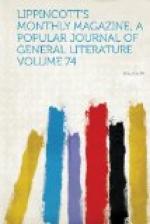[Illustration: Orvieto.]
Where the Paglia and Chiana flow together, at the issue of the charming Val di Chiana, stands Orvieto on its steep and sudden rock, crowned with one of the triumphs of Italian Gothic, the glorious cathedral. After toiling up the ladder-like paths which lead from the plain to the summit of the bluff, and passing through the grand mediaeval gateway along the slanting streets, where even the peasants dismount and walk beside their donkeys, seeing nothing within the whole small compass of the walls save what speaks of the narrowest and humblest life in the most remote of hill-fastnesses, a few deserted and dilapidated palaces alone telling of a period of importance long past, nothing can describe the effect of coming out of this indigence and insignificance upon the silent, solitary piazza where the incomparable cathedral rears its front, covered from base to pinnacle with the richest sculpture and most brilliant mosaic. The volcanic mass on which the town is built is over seven hundred feet high, and nearly half as much in circumference: it would be a fitting pedestal for this gorgeous duomo if it stood there alone. But it is almost wedged in among the crooked streets, a few paces of grass-grown stones allowing less than space enough to embrace the whole result of proportion and color: one cannot go far enough off to escape details. An account of those details would require a volume, and one has already been written which leaves no more to be said;[1] yet fain would we take the reader with us into that noble nave, where the “glorious company of the apostles” stands colossal in marble beside the pillars whose sculptured capitals are like leafy branches blown by the wind; where the light comes rich and mellow through stained glass and semilucent alabaster, like Indian-summer sunshine in autumn woods; where Fra Angelico’s and Benozzo Gozzoli’s angelic host smile upon us with ineffable mildness from above the struggle and strife of Luca Signorelli’s “Last Judgment,” the great forerunner of Michael Angelo’s. It added greatly to the impressiveness that there was never a single human being in the cathedral: except one afternoon at vespers we had it all to ourselves. There is little else to see in the place, although it is highly picturesque and the inhabitants wear a more complete costume than any other I saw in Italy—the women, bright bodices, striped skirts and red stockings; the men, jaunty jackets and breeches, peaked hats and splendid sashes.
The discomfort of Perugia was luxury to what we found at Orvieto, and it was no longer May but December, when it is nearly as cold north of Rome as with us; and Rome was drawing us with her mighty magnet. So, one wintry morning, soon after daybreak, we set out in a close carriage with four horses, wrapped as if we were going in a sleigh, with a scaldino (or little brazier) under our feet, for the nearest railway station on our route, a nine hours’ drive.




